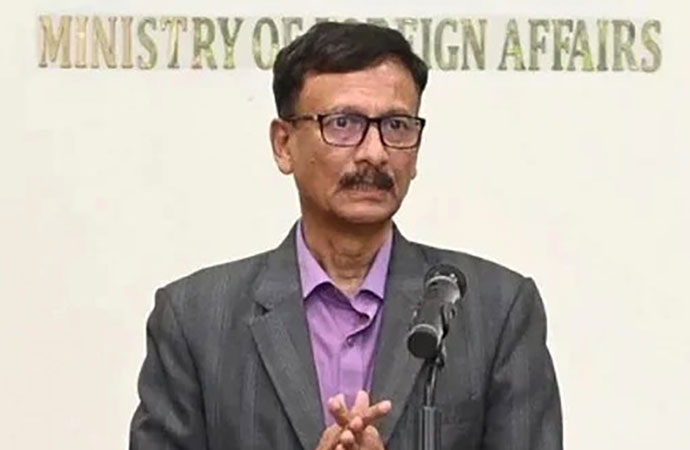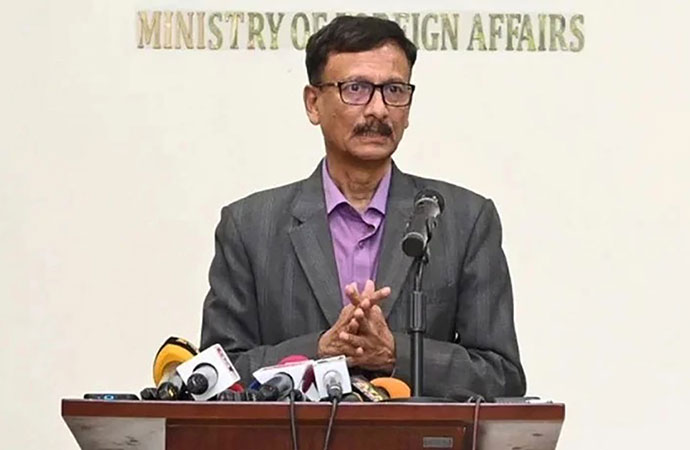Reportage

A firefighter carries a body of a victim from a fire that broke out at a commercial complex in Dhaka, Bangladesh, Friday March 1,2024. Bangladesh's health minister says a fire in a six-story commercial complex in the nation’s capital, Dhaka, has killed several people and injured dozens of others. Photo:: AP/UNB
On the night of February 29, a Thursday, one of Dhaka's most storied streets, Bailey Road, was bustling. It was the start of the weekend, and the date signifying a leap year had been latched on to by the various eateries in particular to offer various promos. It was also one of the last days of Boi Mela - usually as the last day of February it would have been the last day, but this year there was a two-day extension.
Witness accounts of what exactly happened vary, but there seems to be general agreement that around 9.50pm, there was a loud blast, like a gas cylinder blast, on the first floor of the Green Cozy Cottage Building, a residential-cum-shopping complex that contained a number of restaurants, including a Kacchi Bhai on the first floor. The earliest footage now suggests the fire started in the stairwell, which was known to be stacked with cylinders. It quickly spread to other floors, trapping dozens inside. Fire officials stated that the fire spread rapidly due to the presence of gas cylinders in the kitchens of multiple restaurants in the building. Evacuation was also hindered due to smoke in the building's staircase.
Thirteen firefighting units were deployed to the site. Firefighters rescued 75 people from the building and used a crane to evacuate people from the upper level of the charred structure. The blaze was brought under control after two hours.
By then, some 44 people were dead. Two more died in hospital later.
The government ordered an inquiry into the incident. The exact cause of the fire is still under investigation, but officials suspect that the fire started after the explosion of a gas cylinder in the restaurant. Gas cylinders were reported to be on every floor of the building, as well as on staircases. The building did not have a fire exit.
Prime Minister Sheikh Hasina expressed her shock at the loss of lives and said that it was a result of negligence. "What could be more painful than this?" she said, speaking at an unrelated event in Dhaka.
"We always request our architects, at least when they design homes or buildings, (to) keep a small open balcony, a fire exit or ventilation. But architects will not design that properly and also the owners do not want to leave an inch of space," she said.
Other violations were also reported. The Capital Development Authority or RAJUK, the official regulator, said the building was not permitted to open restaurants but it had at least eight food shops.
One survivor said people escaped by heading to the building's roof.
"I knew about the fire when it was at the first floor. We moved to the roof of the building. Around 30 people were there. After the fire was under control, fire service personnel broke into one side of the roof and rescued us," Mohammed Siam said.
Five members of one family were among the dead, while the toll also included students, teachers and two reporters. The Fire Service department said the building owner was served at least three times with notices to correct the building's fire extinguishing system.
Bangladesh has a history of such fires in commercial buildings in Dhaka and outside. Experts say lax monitoring and violation of building codes by construction companies and owners have proved deadly for Bangladeshis.
A recurring issue
In Dhaka, the capital of Bangladesh, the history of fire incidents stretches back decades, with each tragedy laying bare the systemic failures of monitoring and enforcement by the authorities.
The recurrence of these incidents, resulting in loss of lives and property, highlights a persistent cycle of negligence and a lack of proper supervision by the concerned agencies, including the Rajdhani Unnayan Kartripakkha (RAJUK) and the Fire Service and Civil Defence.
This pattern was tragically underscored by the Bailey Road fire, marking yet another dark chapter in Dhaka's ongoing saga of preventable disasters. The Bailey Road catastrophe is not an isolated incident but a continuation of Dhaka's grim legacy of fire tragedies. Experts point to a systemic lack of accountability and supervision, with buildings across the capital flouting fire safety norms and regulations.
The construction of these structures often violates directives from the Fire Service and Civil Defence, lacking essential fire prevention measures such as alarms, adequate water supplies, and fire extinguishing systems.
The result is a cityscape riddled with potential fire traps, posing a constant threat to its inhabitants.
Dr. Adil Muhammad Khan, President of the Bangladesh Institute of Planners (BIP), asserted that the frequent fires could be significantly reduced if the authorities took decisive action against those responsible for the lax approval and supervision of building constructions, and against building owners who neglect fire safety standards.
Dr. Khan emphasised that accountability must extend to RAJUK, the building owners, and even the tenants who, fully aware of the risks, continue to occupy these unsafe spaces.
The recurrence of fire incidents is further compounded by the failure to follow up on investigations after each tragedy. Dhaka has borne witness to several catastrophic fires, including those at Nimtoli, Churihatta, FR Tower, Armanitola, New Market, Moghbazar, and the latest disaster at Bailey Road. These incidents share common threads: mismanagement, the utilisation of risky multi-storied buildings, and a glaring lack of proper supervision, with many buildings operating without the requisite approvals from RAJUK and other regulatory bodies.
Despite repeated pledges from various quarters to transform Dhaka into a risk-free city, these promises have largely gone unfulfilled. Each tragic fire fades from public memory, only to be replaced by the next, in a seemingly endless cycle of devastation. This cycle is exacerbated by the mixed use of residential and commercial buildings, which Dr. Khan identified as a critical risk factor propelling the capital towards further disaster.
An example of this perilous overlap is the Green Cozy Cottage Building on Bailey Road. Despite approvals specifying that only the ground through fourth floors could be used commercially, with the fifth and sixth floors designated for residential purposes, the building predominantly housed restaurants, a clear breach of urban planning and building laws.
Dr. Khan advocated for treating such egregious violations, like the Bailey Road fire, as criminal acts, attributing them to the negligence of RAJUK and other service agencies.
The aftermath of the Bailey Road tragedy has seen calls for comprehensive measures, including the online registration of buildings with detailed usage information, and the public display of notices issued by the government against non-compliant building owners.
Ashraful Islam, the project director of the Detailed Area Plan (DAP) of RAJUK, clarified that the Bailey Road building was authorised only for office use, not for restaurants and showrooms, underscoring the illegal operations that contributed to the tragedy.
The police identified numerous restaurants operating within the building in violation of its approved use. Gas cylinders were stockpiled by the restaurants, highlighting a dangerous collusion between building owners and managers.
Fire Service and Civil Defence Director General Brig Gen Md Moin Uddin noted the absence of fire extinguishing systems in the building, despite multiple notices issued to the owners, who disregarded these warnings.
Anisur Rahman Mia, chairman of RAJUK, stated that legal actions are underway against those implicated in the incident, with ongoing trials for previous fire-related cases. The establishment of a seven-member probe committee to investigate the Bailey Road fire, tasked with reporting their findings within seven working days, represents a step towards addressing these recurring tragedies. However, the broader challenge remains: ensuring compliance with RAJUK's directives, a task complicated by the widespread disregard for regulatory standards, as evidenced by the failure of Mouchak Market authorities to respond to notices. The RAJUK chairman also claimed that nearly 70% of people did not follow their directives after getting approval for buildings.
Eating out
In the heart of Dhaka's upscale neighbourhoods - Dhanmondi, Gulshan, and Banani - a burgeoning restaurant scene thrives within the confines of multi-storey buildings. This rapid expansion, however, brings to light grave concerns over fire safety practices, or the lack thereof. Many of these dining establishments lack comprehensive fire safety measures, relying solely on elevators and a solitary staircase for emergency exits. This inadequate infrastructure places patrons and employees in a precarious position, with their safety hanging in the balance.
Conversations with residents of these areas shed light on these alarming realities, further underscored by the recent tragedy on Bailey Road, which has sown seeds of fear and apprehension among diners. The indiscriminate sprouting of restaurants, many of which have been operating without fire safety licenses for years, exacerbates the risk. These establishments, often housed in structures originally intended for residential use, now serve commercial purposes, thereby complicating the fire safety landscape.
This issue is not confined to a few isolated cases; nearly every alley in these areas is lined with cafes and restaurants, with some buildings entirely dedicated to these businesses. The architectural design, characterised by an extensive use of glass, restricts the inflow of air, and in the event of a fire, leaves breaking the glass as the only means to combat the flames.
The structural layout presents further challenges for emergency evacuation. Narrow staircases, cluttered or locked, significantly hinder the ability of patrons to evacuate safely in case of an emergency, turning what should be a straightforward escape route into a potential trap.
The fear of fire is not an abstract concern for the residents of Gulshan and Banani. Moniruzzaman, a businessman from Gulshan, and Didarul Haq Sunny, another businessman from Banani, voiced their apprehensions about dining out in the post-Bailey Road fire era.
"There's a prevailing fear of taking families to restaurants in the Gulshan-Banani area, as it's unclear which establishments have fire safety measures," Moniruzzaman said. Didarul mentioned ceasing restaurant visits after the Bailey Road tragedy, citing fire safety as a major concern.
Their concerns highlight a critical demand for Dhaka's development authority, RAJUK, to enforce and oversee rigorous fire safety standards across all restaurants.
Dr. Adil Muhammad Khan, President of the Bangladesh Institute of Planners (BIP), echoed these sentiments. He pointed to the widespread practice of converting entire buildings into dining spaces, enveloped in glass, which fundamentally compromises fire safety protocols. The aftermath of the Bailey Road tragedy has left a palpable sense of urgency among citizens and experts alike, calling for immediate action from RAJUK and other relevant authorities to mitigate the risk of future incidents.
Dr. Adil advocated for detailed inspections of fire safety equipment, such as fire extinguishers and alarms, and insisted on comprehensive safety audits for all multi-storey and specially purposed buildings.
Despite existing regulations mandating two staircases in buildings, the reality on the ground reveals a stark misuse of these provisions, with designated fire exits often repurposed as storage areas. This blatant disregard for safety norms necessitates a stringent enforcement of building codes and fire safety regulations.
RAJUK Chairman Anisur Rahman Mia acknowledged the challenges at hand, committing to a series of actions aimed at identifying and rectifying establishments lacking in fire safety measures. He drew attention to the widespread issue of illegal commercial activities within residential buildings, underscoring RAJUK's dedication to enforcing legal and safety standards.
With over 517,000 buildings under its jurisdiction in Dhaka, of which only 200,000 are approved, RAJUK faces a daunting task. An astonishing 90% of the approved buildings deviated from their original designs, complicating the enforcement of fire safety and building codes, the public agency says.
A series of unfortunate fires
Nimtoli
As many as 124 people were killed and 50 were injured as a transformer exploded at Nimtoli of Chankharpool on June 3, 2010. The fire department speculated that the fire was fanned by chemicals and other flammable products stored in shops. The overcrowded area also made it difficult for firefighters to bring the blaze under control
Churihatta
A total of 71 people died while several hundred people were injured when a gas cylinder exploded at Wahed Mansion in Churihatta of Chawkbazar area on February 20, 2019. The fire was reported to have originated in the explosion of a car's gas cylinder, which triggered further fires in buildings and nearby gas cylinders.
FR Tower in Banani
At least 27 people died and scores were injured as a fire broke out at the multi-purpose FR Tower on March 28, 2019.
Moghbazar
At least twelve people were killed and 200 people were injured in an explosion at a building in Moghbazar Wireless area on June 27, 2021.
Bangabazar, New Super Market
A number of shops were gutted in a fire which broke out at Bangabazar Complex on April 4, 2023. Close to 6,000 stores were gutted, resulting in a loss of at least BDT 10 billion. Just 11 days after the Bangabazar shopping complex fire, another devastated Dhaka's New Super Market. Close to 200 shops were gutted and according to primary estimates, each store had merchandise worth about Taka 20 lakh to one crore.
Additional reporting by Masudul Hoque

























Leave a Comment
Recent Posts
Remembering Kalidas Karmakar ( ...
The art world remembers Kalidas Karmakar, a visionary whose creativity ...
An Evening with Shishir Bhatta ...
Cosmos Art Echo, the artist talk initiative of Gallery Cosmos and Cosm ...
Myanmar denies genocide, calls Rohingya crackdown co ..
Yes, of course
Earth’s average temperature last year hovered among ..
Bangladesh and Singapore: A Tale of Two Nations